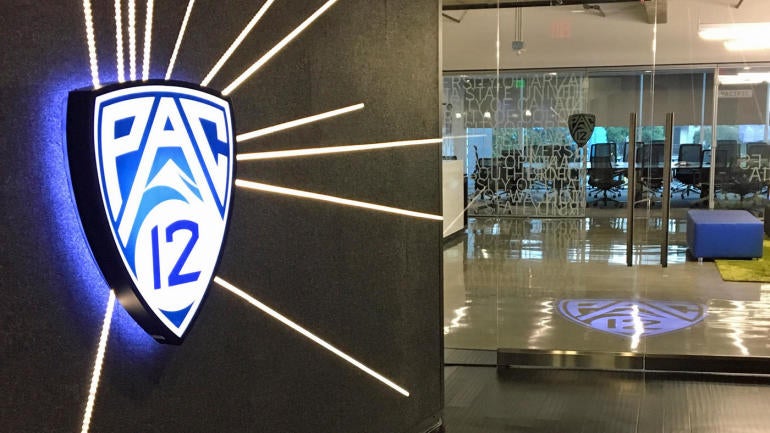
The viability of the Pac-12 Network is one of the most important aspects being debated amid the disintegration of the conference, sources tell CBS Sports.
The network continues to broadcast out of the Bay Area despite low viewership with only an estimated 15 million subscribers accessing the channel. The Pac-12 Network also operates six regional sports channels (Arizona, Bay Area, Los Angeles, Mountain, Oregon, Washington) focusing on different conference schools.
The general assumption is that the Pac-12 Network will be sold for parts as the Pac-12 goes away, but could it serve as role as part of a reorganized league that includes Oregon State and Washington State?
"That's what we're trying to figure out," a person involved in the negotiations between the schools told CBS Sports. "Also, it may have to be sold off piece by piece. There is value in the technology.
"I think it's a two-fold question: Is there a way to salvage it? Yes, but we see where cable is headed right now; there is an expiration date for the Pac-12 Network, SEC Network whatever it is. Those that go straight to streaming will live forever."
Oregon State and Washington State are seeking a restraining order Monday that would halt a Thursday board meeting of Pac-12 presidents called by commissioner George Kliavkoff. The schools contend that they have sole voting rights as the 10 other schools have stated their intention to migrate to the Big Ten and Big 12.
Sources say the full complement of 12 presidents have not met since before last summer when news leaked of USC and UCLA going to the Big Ten. The issue presented by Oregon State and Washington State: Why would the CEOs meet as an entire body now that the league is fractured?
"There are 10 public declarations and welcomes by [other] conferences," Washington State athletic director Patrick Chun told CBS Sports. "That leaves two [schools]. We're asking the court to reaffirm a board meeting should only contain two presidents."
All the league knows for sure at is that there's approximately $50 million worth of NCAA Tournament "units" waiting to be distributed amongst conference members. Those units represent NCAA Tournament revenue -- based on a rolling six-year average -- paid back to the schools based on the league's on-court success.
Countering that revenue is $50 million owed to Comcast in an ongoing scandal. The league also has been sued by two former employees, including its former CFO, regarding that dispute. What's not clear is whether there are any net assets after those expenses.
The hearing on the restraining order is expected to be completed around 2 p.m. ET on Monday at Whitman County Superior Court in Washington.
Oregon State and Washington State are seeking further information from the Pac-12 before they proceed. The general assumption is that the Beavers and Cougars will eventually assimilate into the Mountain West. However, even the wording of such a move is fraught with legalities. Someone, somewhere still owns the name "Pac-12."
Could the two schools retain enough assets from the conference to have the Mountain West move into the Pac-12 as opposed to them leaving the conference?
"What [the name is] worth is up for debate," an administrative source at one of the two remaining Pac-12 schools told CBS Sports. "For two schools, there is a lot of pride in that brand. I know for a bunch of schools on the West Coast, they'd love to play under that banner. We're just trying to keep every option open."
So, could the much-criticized Pac-12 Networks actually survive? That is doubtful, according to industry insiders. The old MountainWest Sports Network folded 11 years ago after six years of existence.
The Big 12 entertained thoughts of a network at one point but was told there were not enough eyeballs to make it viable. In its prior media rights deal, the league parked a lot of content on ESPN+, the network's streaming platform. That has essentially acted as a de facto linear network for the Big 12.
But could a Pac-12 Network be sustainable with the addition of the entire Mountain West? The possibility exists -- even remotely -- until the value of what remains is determined.
Oregon State and Washington State are desperately trying to hold onto the College Football Playoff access provided by the Pac-12 brand. Even if they do retain the conference name, such a shift in program prominence will most likely lead to a reduction in the number of autonomy conference and automatic qualifiers (six) into the expanded 12-team bracket.
"It hasn't dissolved yet; we have to see what happens. … Respectfully, the Pac-12 still exists. There has to be clarity," SEC commissioner Greg Sankey said Saturday.
NCAA bylaws state a conference must be composed of at least eight teams. However, there is a two-year grace period for a league to maintain that number. On paper, are the Cougars and Beavers a viable two-team conference?
"The CFP is not the NCAA," Sankey said. "I think we all understand that."





















